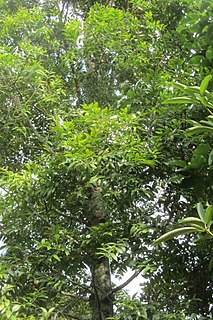
Agathis kinabaluensis is a tree of Borneo in the conifer family Araucariaceae. The specific epithet kinabaluensis is from the Latin, referring to the species being native to Mount Kinabalu in Sabah.
Palaquium beccarianum is a tree in the family Sapotaceae. It is named for the Italian naturalist Odoardo Beccari.
Palaquium calophyllum is a tree in the family Sapotaceae. The specific epithet calophyllum means "beautiful leaves".
Palaquium cryptocariifolium is a tree in the family Sapotaceae. The specific epithet cryptocariifolium refers to the resemblance of the leaves to those of the tree genus Cryptocarya.
Palaquium dasyphyllum is a tree in the family Sapotaceae. The specific epithet dasyphyllum means "thickly hairy leaves".
Palaquium elegans is a tree in the family Sapotaceae.
Palaquium herveyi is a tree in the family Sapotaceae.

Palaquium gutta is a tree in the family Sapotaceae. The specific epithet gutta is from the Malay word getah meaning "sap or latex". It is known in Indonesia as karet oblong.
Palaquium hexandrum is a tree in the family Sapotaceae. The specific epithet hexandrum means "six stamens", referring to the flowers.
Palaquium hispidum is a tree in the family Sapotaceae. The specific epithet hispidum means "coarsely hairy, bristly", referring to the species' twigs, buds, leaves and inflorescences which have such hair.
Palaquium leiocarpum is a tree in the family Sapotaceae. The specific epithet leiocarpum means "smooth fruit".
Palaquium lisophyllum is a tree in the family Sapotaceae. The specific epithet lisophyllum means "smooth leaves".
Palaquium majas is a tree in the family Sapotaceae. The specific epithet majas is from the Dayak word for the orang-utan of Borneo, referring to the brownish indumentum.
Palaquium microphyllum is a tree in the family Sapotaceae. The specific epithet microphyllum means "small leaves".
Palaquium ottolanderi is a tree in the family Sapotaceae.
Palaquium pseudocuneatum is a tree in the family Sapotaceae. The specific epithet pseudocuneatum means "somewhat wedge-shaped", referring to the leaf base.
Palaquium pseudorostratum is a tree in the family Sapotaceae. The specific epithet pseudorostratum is for the species' similarity to Palaquium rostratum.
Palaquium quercifolium is a tree in the family Sapotaceae. The specific epithet quercifolium refers to the leaves' similarity to the genus Quercus.
Palaquium rufolanigerum is a tree in the family Sapotaceae. The specific epithet rufolanigerum means "reddish woolly", referring to the indumentum.

Tenompok Forest Reserve is a protected forest reserve in Ranau District of West Coast Division, Sabah, Malaysia. It was designated as a Class 1 Forest Reserve by the Sabah Forestry Department in 1984. Its area is 1,984 hectares (19.84 km2). A former reserve, the Kampung Bundu Tuhan Native Residence Reserve, occupied what is now the eastern portion of Tenompok. The reserve is mountainous, reaching 1,660 metres (5,450 ft) above sea level. Vegetation consists of lower montane forest and montane kerangas forest. Both share a similar species composition, although trees in montane keranga forests are smaller. The reserve's Tomis River is a tributary of the Tuaran River. The area of the reserve has never received significant logging, aside from small amount near what are now its borders. This small logging is thought to be carried out by nearby villages for local use. There is also some agricultural encroachment. The reserve lies between Kinabalu Park and Crocker Range National Park. One farmer has a house within the reserve. There are several settlements around the reserve, along with agricultural land.



